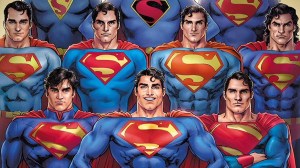
The Fuse in a Nutshell
‘Homicide’ in Space.
Videos by ComicBook.com
‘Babylon 5’ Without the Aliens
Isaac Asimov Writing a Police Procedural.
This is the story of a geostationary space station nicknamed The Fuse.
Specifically, it’s about 60-something Detective Klementina Ristovych, one of the few homicide detectives on the station. Also, she’s a Fuse OG, having been an engineer in the original build of the station. She’s in deep on the station, knows a lot about the place, and provides the perfect guide for the story.
You don’t need an omniscient narrator to explain things to the reader when you have a character who, for very good story reasons, already knows it all.
Even better, we have the newest homicide cop to the station, Ralph Dietrich. He’s just transferred from Germany and his first day is a doozy. (See the first trade paperback collection, “The Russia Shift.”) He also has a doozy of a secret he’s hiding which, little by little, we start to see.

It all blows up in his face (of course) in the fourth storyline of the series, titled “Constant Orbital Revolutions.” The sixth and final part of the storyline came out a couple of weeks ago. The fourth trade of the series will collect it in February.
And that’s all she wrote. The series is on hiatus, having told its initially planned and designed story. I’m sure Not Spectacular sales didn’t hurt that, either. Sigh. Why do the great ones always have to go away like that?
So, the good news: These four trade paperbacks tell a complete and satisfying story.
The bad news: You won’t see any more of it in the near future.
Don’t let that scare you away, though. It’s still 24 issues of great comics storytelling.
Spoiler Free Review of This Fourth Story
This might be the dumbest idea in comics journalism’s history. Even dumber than The Listicle and Breaking News alerts for a Teaser to a Movie’s Trailer combined.
I’m about to review the fourth and final story arc of a series without spoilers.
At the front of issue #23, the “Previously…” text page begins:
“This is part 5 of a 6 part story, and also contains massive spoilers for literally every issue of the series so far.”
It then goes on to name the first three trade paperbacks and suggests you read those two.
I’ll co-sign that.
“The Fuse” is not one of those series where, in retrospect, it had a shaky start but eventually found its footing. No, “The Fuse” came out swinging. Right from the first page, it was strong. It’s become stronger not because the creative team just recently learned their craft, but because the world they’ve designed has become so familiar and well defined that they’ve been able to tell deeper and richer stories.
So, yes, read all four trades and read them in order. You won’t be disappointed. Antony Johnston’s scripts amp up the suspense and the thrills in every arc as the story goes along. The story structure is sound. You get a death in the first issue which leads to an in-depth investigation that has its shares of set-backs and runarounds, before things look really bleak at the end of the fifth issue, and the sixth issue is a blow-out where every promise from the first four issues is paid out.
This is not a template. This is good storytelling.
The character work is strong. The two leads of the series are destined to be stars. They both can carry a scene on their own, but together create the best kind of story sparks. The dialogue crackles between the two, coming from different worldviews and experiences, often loaded with (understood but not directly stated) different goals.
With this story arc, there’s an extra layer on top of all of that, as Johnston neatly concludes all of the overall story arcs of the series. Every hint that’s been dropped pays off here in a satisfying way. Plus, a couple of last minute twists make you want to read the whole six-parter over again. (“How did I not see that coming?!?”)
What more could you ask for?
On the Art Side of Things
Justin Greenwood’s art shines in the fourth arc, despite not having as much visually interesting and foreign stuff to work with. In previous arcs, he’s been able to draw races happening on the outside of the station, space walks (and space races), and zero G sunrise hangouts. In the fourth arc, things feel more confined and more controlled, which fits the story well. There’s an awful lot of labs and interrogation rooms and glowing computer screens in lieu of sun and clouds and mountain ranges. But that’s the story — it’s as much an internal investigation as it is a homicide case.
Even the promise of zero gravity sports is almost completely not seen, which might have been the most dynamic thing for an artist to draw in this storyline. You’ll have to settle for tense conversations punctuated by the occasional breaking-and-entering in this arc.
The funny thing is, I didn’t even notice this until I sat down to write this review. I was so wrapped up in the story that I didn’t notice it was fairly stripped down like this. I wasn’t bored waiting for a fist fight to start or anything like that. Johnston’s script and Greenwood’s storytelling kept me to wrapped up to notice that those things weren’t happening.

Greenwood handles those talking heads scenes with a variety of angles and panel sizes. You don’t get bored looking back and forth. The scenes don’t feel repetitious.
Greenwood’s got enough skills to keep himself busy, primarily at Oni Press, where he’s the current series artist on Greg Rucka’s “Stumptown.” At one point, he had credits for drawing three issues of three different series in the same month. (“Stumptown,” “The Fuse,” and Marc Guggenheim’s “Stringers”)
That’s some early 90s Ron Lim-like output right there.
It’s well-earned, though.
It’s More Than Just the Writer and Artist
Shari Chankhamma’s colors are consistent throughout the series, with slightly-gradated backgrounds and a ‘simple’ coloring style in the foreground. She uses a few spare cuts in her colors, with soft edges and slight gradations to phase between them.
The Fuse is a harshly lit place, and Chankhamma’s colors reflect that, with plenty of sickly greens contrasting with brighter oranges in more open or opulent areas.
Ryan Ferrier goes with no-frills mixed case lettering. Aside from the scene introductions in all-caps sans serif fonts, there’s not much else to this book from a lettering perspective. Sound effects are super rare, used only to put an exclamation point on an important moment in the story or the scene.
These last six issues have no letters columns, though the last issue does have a text page explaining the series’ hiatus.
Wrap It Up, Augie
I like “The Fuse”. A lot. At a time when I was looking for some kind of science-fiction series that didn’t become total fantasy, it showed up. When I wanted something more space bound but without being completely alien, Johnston and Greenwood built this world for me to enjoy.
“The Fuse” is an intelligent and well-reasoned police procedural set on an interesting and well thought out space station. It’s both familiar and wonderfully imaginative at the same time. Bravo.
I really hope it comes back someday, in some format…









